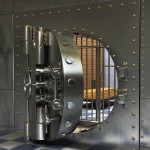How UK's Largest Gold Heist Was Laundered

One of the many scandalous secrets revealed by the release of the Panama Papers is the story of how Mossack Fonseca helped launder the proceeds of Britain's largest ever gold heist.
According to leaked documents, Mossack Fonseca co-founder Jürgen Mossack helped Gordon Parry set up shell companies to launder the proceeds from the 1983 Brinks-Mat gold heist. Fonseca later worked as Parry's counsel to counter efforts by UK police to seize the laundered money.
Britain's "Crime of the Century"

In 1983, six robbers, with the help of an inside man, broke into the Brinks-Mat vault warehouse near Heathrow Airport. Their goal was £3 million in cash being stored in one of the vaults. After dousing the guards in gasoline and threatening set them on fire, they obtained the combination to the vaults. When they swung one vault's door open, they found something that criminal dreams are made of -- 3.5 metric tons of gold bullion.
The haul of gold bullion, loose diamonds and cash totaled £26 million in 1983 pounds, and would be worth £78 million today.
Called "The Crime of the Century" by some newspapers, the gold heist galvanized the nation, not to mention the nation's law enforcement agencies. Some of the robbers were soon caught due to suddenly making extravagant purchases (such as estates in Kent.) The web of robbers, fences, and money launderers soon devolved into a bloodbath. with at least 20 deaths directly or tangentially involved with the robbery. One victim was Charlie Wilson, the money man in the Great Train Robbery. The latest was John "Goldfinger" Palmer, killed at his mansion last July.

Only 30% of the stolen loot has been accounted for. Some of the remaining 70% went into the first large-scale import of ecstasy into the UK, and several real estate ventures worth millions of pounds each. Some experts estimate that these deals have increased the proceeds of the gold heist loot by tenfold. So much gold from the robbery hit the market, that it is said any gold necklace bought since 1993 is probably made from Brinks Mat gold.
Laundering Blood Money
One of the men brought in by the robbers to launder the proceeds from the heist was real estate developer Gordon Parry (not to be confused with Brian Perry, who was hired to smelt some of the gold.) Parry and his partner, lawyer Michael Relton, ran Brinks Mat money that had  been laundered in Switzerland into real estate deals, then ran the proceeds through more shell companies. A 1992 article in the Independent asserts that Parry and his partner opened up at least 170 fake accounts just in the Isle of Man. Other evidence led to the Channel Islands, the Caribbean, Spain, and Florida. Parry escaped capture in 1988 by driving off at high speed with a police detective hanging from his car, while Relton was caught and sentenced to 12 years for money laundering. Parry was caught in Spain in 1990 and extradited to the UK. Brian Perry hired a hit squad to kill Parry before he could talk, but the plan failed. (Perry himself was executed outside his taxi business in 2001.) Parry was sentenced to 10 years in prison for money laundering.
been laundered in Switzerland into real estate deals, then ran the proceeds through more shell companies. A 1992 article in the Independent asserts that Parry and his partner opened up at least 170 fake accounts just in the Isle of Man. Other evidence led to the Channel Islands, the Caribbean, Spain, and Florida. Parry escaped capture in 1988 by driving off at high speed with a police detective hanging from his car, while Relton was caught and sentenced to 12 years for money laundering. Parry was caught in Spain in 1990 and extradited to the UK. Brian Perry hired a hit squad to kill Parry before he could talk, but the plan failed. (Perry himself was executed outside his taxi business in 2001.) Parry was sentenced to 10 years in prison for money laundering.
Panama Papers and British Gold
Britain's "Crime of the Century" returned to the front page this week with the release of the "Panama Papers" -- 2.6 terabytes information documenting money laundering services provided by the firm of Mossack Fonseca. The company specializes in setting up shell companies for the ultra rich (including drug lords, heads of state, and companies under sanction for aiding North Korea and Iran.) Reporters combing through the over 11.5 million documents found a name familiar to Scotland Yard -- Gordon Parry. Parry had contacted Mossack Fonseca a mere 16 months after the Brinks Mat gold heist to set up a shell company. While MF denied knowing that the company was being used to launder the Brinks Mat loot, leaked documents show that co-founder Jürgen Massock not only knew the truth, but became Parry's legal counsel in efforts to hide the money from the police.
Money Laundering Timeline
Like anything else involving the Brinks Mat gold heist, the dealings between Gordon Parry and Massock Fonesca are convoluted. The following timeline is used as a synopsis of the chain of events.
- 1983: Brinks Mat Gold Heist is pulled off.
- 1984: A Jersey Island company named Centre Services contacts Massock Fonesca regarding setting up a Panamanian shell company. Centre Services is one of the many shell companies that Gordon Parry has already set up.
- 1985: Centre Services chooses the name Feberion, Inc for the shell company. Jürgen Massock is named director, while MF handles legal paperwork for the company. Two men in the Channel Islands are also named to the board, to present the appearance of legitimacy.
- 1985: Two bearer shares are issued by the board of Feberion, and held at Centre Services for the unnamed owners.
- 1986: London Metropolitan Police raid Centre Service's office in Jersey. Among the papers seized are the two bearer shares in Feberion. The company is now legally owned by the police.
- 1986: A person affiliated with Centre Services contacts Jürgen Mossack to inform him of the raid. They also reveal that the companies are controlled by the Brinks Mat robbers. He is urged to immediately resign from Feberion's board. In a letter to co-founder Ramón Fonesca, Mossack notes “The company itself has not behaved illegally, but it could be that the company invested money through bank accounts and properties that was illegitimately sourced."
- 1986: Gordon Parry replaces Centre Services with a shell company in Panama.
- 1986: Parry escapes from his mansion before police arrive.
- 1987: Jürgen Mossack starts acting as Parry's legal advisor. Mossack arranges for the new board of Feberion to issue 98 new shares, diluting the two bearer shares held by the police. Parry has control of the company once again.
- 1987: Parry evades capture in Britain and hides out in Spain.
- 1990: Parry is caught hiding out in Spain, and extradited.
- 1992: Gordon Parry, Brian Perry, Jean Savage, and Patrick Clark are convicted of laundering Brinks Mat money, and sent to prison. Parry received a 10-year sentence.
- 1995: Lawyers for Brinks Mat gain control of Feberion. Mossack Fonesca disassociates itself from the company and Gordon Parry, who was still in jail.
- 1995: Brinks Mat lawyers sell Parry's mansion. The buyer was Irene Beaumont -- Parry's wife, who had been living there the whole time.
- 2002: Gordon Parry released from prison, rejoins wife at their estate.
Despite serving 10 years for money laundering, Gordon Parry could be considered one of the lucky ones involved with the Brinks Mat gold heist -- he's still alive.
The opinions and forecasts herein are provided solely for informational purposes, and should not be used or construed as an offer, solicitation, or recommendation to buy or sell any product

Steven Cochran
A published writer, Steven's coverage of precious metals goes beyond the daily news to explain how ancillary factors affect the market.
Steven specializes in market analysis with an emphasis on stocks, corporate bonds, and government debt.
